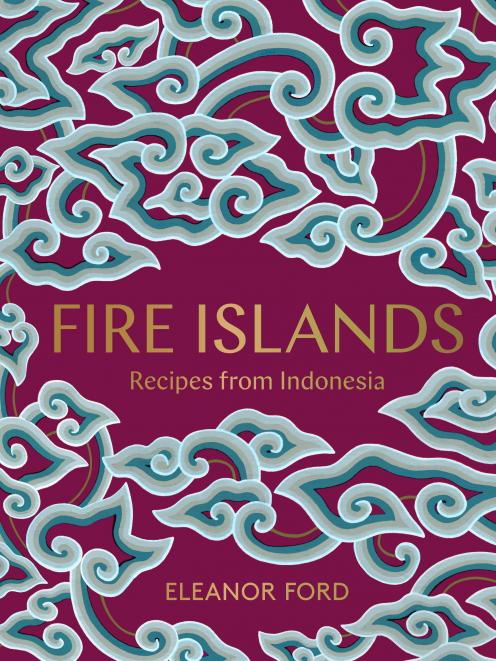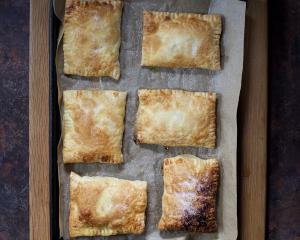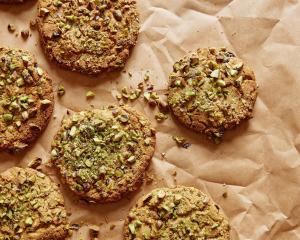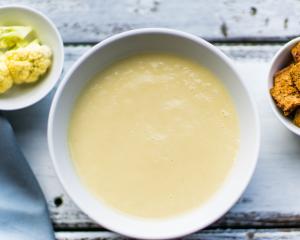

''This is my way of bringing the flavours of a country I love home with me, edible souvenirs I can relish and share.''
With descriptions of Indonesia's various islands, culture and eating practices, Ford paints a picture of a diverse nation which has been influenced by many cultures - India, China, Malaysia, Europe and the Middle East - over the centuries.
''For a land that was once the beating heart of the spice trade, it is curious that Indonesian food is characterised by its freshness.''
Rather than relying on dried spices, fresh ingredients - ginger, galangal, chilli, lemon grass, shrimp paste, turmeric, palm sugar - are pounded to spice pastes which form the foundation of most of the recipes.
She recommends five store-bought cupboard ingredients - kecap manis, Indonesian palm sugar, tamarind paste, shrimp paste and crisp-fried shallots - to start with.
An Indonesian table often has four or five dishes with rice at its centre and the food is served at room temperature.
She breaks the book up into chapters based on flavours - ingredients for fragrance, for spice, for heat, for bitterness, for umami and sweetness and crunch.
 Photos: Kirstin Perers
Black rice steam cake
Photos: Kirstin Perers
Black rice steam cake

The best recipes, ones that are really loved, used and shared, invariably have history. This cakes tale started with a Dutch colonial past that brought a taste for cake to Indonesia. Using a base of black rice flour with its bold, nutty flavour is a local addition.
Aisah Wolfard learnt the recipe from her mother, and in turn shared it with my friend Julia Winterflood. They would sit together as students on the balcony of Aisah's home in the northern hills of Badung and eat it with black coffee.
The cake is decadent yet delicate, smooth yet springy, and has a fabulous inky colour. It keeps well for days in a tin, the texture changing from slightly moussey when freshly steamed to damp and squidgy as it matures.
Serves 8
Ingredients
200g butter
250g black glutinous rice flour
6 large eggs
250g (generous 1 cup) caster sugar
½ tsp salt
1 tsp baking powder
2 Tbsp sweetened condensed milk
½ teaspoon vanilla extract
Method
You'll need a cake tin and a steaming pan or basket large enough to hold it. I use a 22cm bundt tin, which fits neatly into my steamer.
Melt the butter and use a little to grease the inside of the cake tin well. Dust with just a little of black flour to help stop the cake sticking. Start the water boiling underneath the steamer so it is ready for the cake.
In a large bowl, whisk together the eggs, sugar and salt to get a frothy mixture with the sugar dissolved. Stir in the black glutinous rice flour and baking powder.
Stirring as you go, gradually add the condensed milk, the vanilla extract and finally the melted butter. Keep stirring until the mixture is smooth and velvety.
Pour into the cake tin and sit in the steaming basket. Wrap the lid with a clean tea towel - this will stop water dripping on to the cake and create a tight seal.
Steam over a medium-low heat (making sure there is always water in the pan). How long it takes depends on the size and shape of your pan. Aisah's takes 25 minutes, mine closer to 40.
Check every 5 minutes or so towards the end of the cooking time. The top should be gently springy with not too much wobble below; then poke in a skewer to check the middle has a delicate crumb rather than raw batter.
Remove from the steamer and leave to cool for 10 minutes in the tin before turning out on to a rack to cool. Serve with strawberries perhaps, or for a real Indonesian touch, grated mild cheddar cheese.
 Potato tuturuga
Potato tuturuga

Lime leaves, mint and lemon basil perfume this spicy, savoury curry. Tuturuga is made by the Minahasen people of North Sulawesi, where the name means turtle - the original meat cooked with potatoes in this red spice paste.
Today chicken or beef is more typical, but I keep mine meat-free as I think the potatoes cloaked in the spiced coconut milk are the best bit.
Serves 2-4
Ingredients
500g potatoes, peeled
1 Tbsp oil
2 lime leaves
250ml (1 cup) coconut milk
1 tsp sea salt
small bunch of lemon basil leaves, shredded
small bunch of mint leaves, shredded
juice of half a lime
Bumbu spice paste
4 small red Asian shallots, peeled
4 garlic cloves, peeled
3 large red chillies, half seeded
2cm ginger, peeled
3cm turmeric, peeled, or 1 teaspoon ground turmeric
6 candlenuts or 10 blanched almonds
Method
Start by making the bumbu spice paste. Roughly chop the fresh ingredients and grind to a paste in a food processor, adding a little water if needed to help it come together.
Cut the potatoes into 4cm-5cm chunks.
Heat the oil in a pan that will be large enough to hold the potatoes later. Scrape in the bumbu and fry until fragrant and the rawness has gone. Add the lime leaves and wilt in the heat of the spices.
Add the potatoes, coconut milk and salt and top up with just enough water to cover the potatoes. Bring to a slow boil and cook uncovered until the potatoes are tender and the sauce has reduced to a good consistency, about 20-30 minutes.
Leave to cool a little then stir through the lemon basil and mint. Taste for seasoning and brighten the flavours with a zap of lime juice.
Menu ideas: This also makes a great accompaniment to roast chicken or steamed fish.
 Steamed fish parcels with lemon basil
Steamed fish parcels with lemon basil

Opening your own banana leaf parcel at the table to reveal a delicately fragranced fish fillet brings pleasing drama to a meal. If you can't find banana leaves, use foil instead, but they are worth seeking out in Asian supermarkets for the subtle herbal taste they impart.
Serves 4
Ingredients
4 150g skinless white fish fillets
juice of half a lemon
2 Tbsp oil
200ml (generous ¾ cup) coconut milk
30g lemon basil or Thai basil
1 bird's eye chilli, seeded and sliced
1 large tomato, sliced into 8 rounds
Bumbu spice paste
1 lemongrass stick
1 large red chilli, seeded
1 birds eye chilli (optional, for heat)
3 small red Asian shallots
3 garlic cloves
2cm galangal, skin scrubbed
1cm ginger, peeled
1cm turmeric, peeled, or ½ tsp dried turmeric
banana leaves or foil, for wrapping
Method
In a bowl, toss the fish fillets with lemon juice, salt and pepper and leave to marinate out of the fridge while you prepare the bumbu.
Trim the lemongrass to the pale white and lilac part, bruise with the handle of a knife then finely slice. Roughly chop the remaining bumbu ingredients and blend everything to a paste in a food processor or high-speed blender.
Adding a little water will help the blades bring everything together. Heat the oil in a small frying pan and cook the bumbu over a medium heat, stirring often, for about 10 minutes until the raw garlic taste has gone and the oil separates from the spices.
Add the coconut milk and bumbu to the fish, turning to coat the fillets well.
Cut eight pieces of softened banana leaves, each large enough to wrap a fillet. Lay them out in double thickness. Lay a generous layer of lemon basil leaves on each and sit a fillet on top, making sure you include all the coconutty marinade.
Scatter a little chilli over the top followed by two slices of tomato, then bury under another mound of lemon basil. Wrap the parcels well, securing with bamboo skewers or a ribbon of banana leaf. If you have time, leave to marinate in the fridge for up to 4 hours.
Preheat the oven to 180degC .
Space out the parcels on a baking sheet. Bake for 20 minutes and leave to rest for 5 minutes before opening the parcels at the table.
Note: We tried spiced fish parcels in Java that my husband loved so much he would have them as the lead recipe.
The 4 fish fillets are coated in a bumbu spice paste made from the following:
4 large red chillies (seeded),
2 lime leaves,
3 candlenuts or 6 blanched almonds,
3 garlic cloves,
1 lemongrass stick,
2cm kencur (herb, omit if can't source it),
1cm turmeric,
1 tsp coriander seeds,
1 Tbsp tamarind paste,
1 tsp salt,
½ tsp sugar
1 egg and 1 Tbsp oil
Wrap in parcels and cook as above.












